Camponotus linnaei
| Camponotus linnaei | |
|---|---|

| |
| Scientific classification | |
| Kingdom: | Animalia |
| Phylum: | Arthropoda |
| Class: | Insecta |
| Order: | Hymenoptera |
| Family: | Formicidae |
| Subfamily: | Formicinae |
| Tribe: | Camponotini |
| Genus: | Camponotus |
| Species: | C. linnaei |
| Binomial name | |
| Camponotus linnaei Forel, 1886 | |
| Subspecies | |
| |
| Synonyms | |
| |
I have repeatedly taken linnaei in various neotropical localities, always nesting in dead twigs, and have noticed that a colony consists of only one or two dozen minor workers and a few soldiers. The worker caste is therefore strongly dimorphic as in the species of Colobopsis. (Wheeler 1934)
Identification
Distribution
Latitudinal Distribution Pattern
Latitudinal Range: 20.85574444° to -19.6°.
| North Temperate |
North Subtropical |
Tropical | South Subtropical |
South Temperate |
- Source: AntMaps
Distribution based on Regional Taxon Lists
Neotropical Region: Brazil, Colombia (type locality), Costa Rica, Ecuador, Guatemala, Honduras, Mexico, Panama, Peru.
Distribution based on AntMaps
Distribution based on AntWeb specimens
Check data from AntWeb
Countries Occupied
| Number of countries occupied by this species based on AntWiki Regional Taxon Lists. In general, fewer countries occupied indicates a narrower range, while more countries indicates a more widespread species. |

|
Estimated Abundance
| Relative abundance based on number of AntMaps records per species (this species within the purple bar). Fewer records (to the left) indicates a less abundant/encountered species while more records (to the right) indicates more abundant/encountered species. |

|
Biology
Castes
Worker
Images from AntWeb
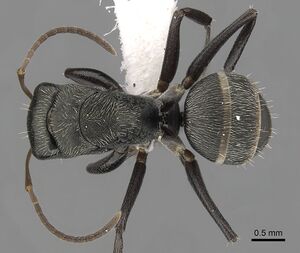 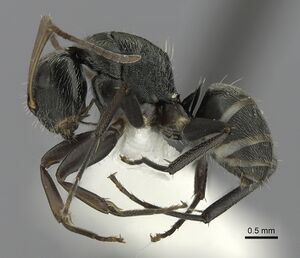 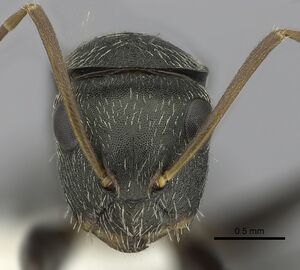 
| |
| Worker. Specimen code casent0280085. Photographer Shannon Hartman, uploaded by California Academy of Sciences. | Owned by PSWC, Philip S. Ward Collection. |
 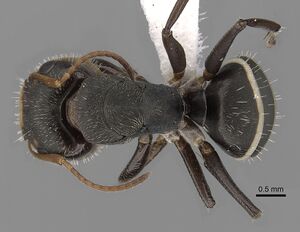  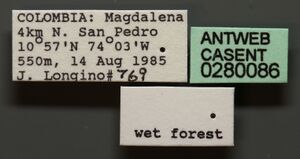
| |
| Worker. Specimen code casent0280086. Photographer Shannon Hartman, uploaded by California Academy of Sciences. | Owned by PSWC, Philip S. Ward Collection. |
   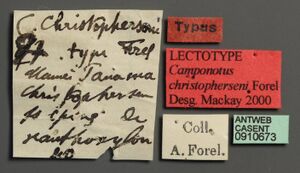
| |
| Lectotype of Camponotus christopherseni. Worker (major/soldier). Specimen code casent0910673. Photographer Z. Lieberman, uploaded by California Academy of Sciences. | Owned by MHNG, Geneva, Switzerland. |
 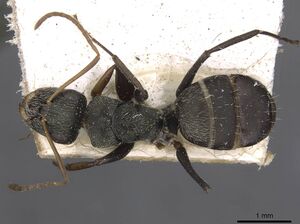  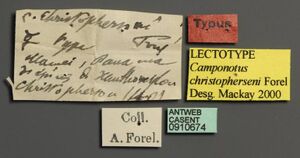
| |
| Paralectotype of Camponotus christopherseni. Worker. Specimen code casent0910674. Photographer Z. Lieberman, uploaded by California Academy of Sciences. | Owned by MHNG, Geneva, Switzerland. |
 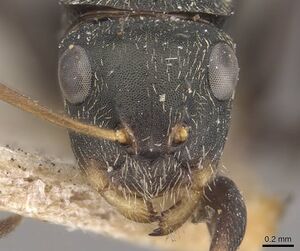  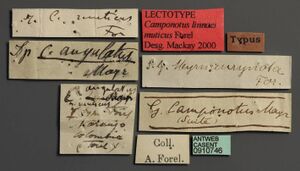
| |
| Lectotype of Camponotus linnaei muticus. Worker. Specimen code casent0910746. Photographer Will Ericson, uploaded by California Academy of Sciences. | Owned by MHNG, Geneva, Switzerland. |
 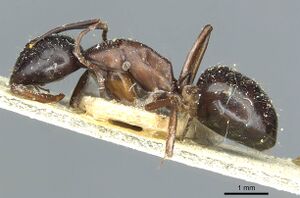 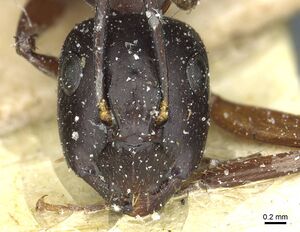 
| |
| Syntype of Camponotus linnaei. Worker. Specimen code casent0911965. Photographer Z. Lieberman, uploaded by California Academy of Sciences. | Owned by NHMB, Basel, Switzerland. |
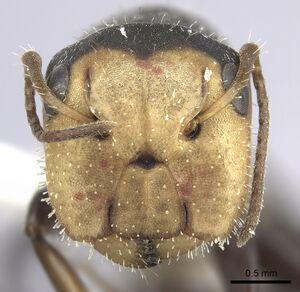  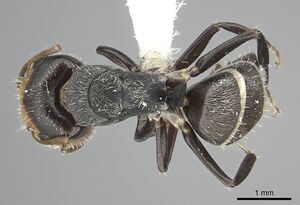 
| |
| Worker. Specimen code inbiocri001280105. Photographer Will Ericson, uploaded by California Academy of Sciences. | Owned by JTLC. |
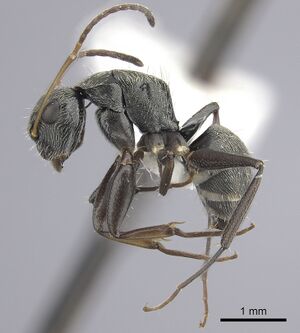 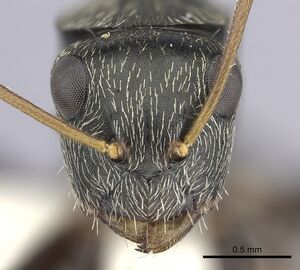  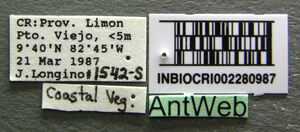
| |
| Worker. Specimen code inbiocri002280987. Photographer Will Ericson, uploaded by California Academy of Sciences. | Owned by JTLC. |
Queen
Images from AntWeb
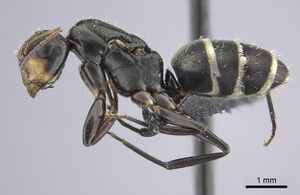   
| |
| Worker. Specimen code inbiocri001236183. Photographer Will Ericson, uploaded by California Academy of Sciences. | Owned by INBio. |
Nomenclature
The following information is derived from Barry Bolton's Online Catalogue of the Ants of the World.
- angulatus. Camponotus angulatus Mayr, 1870a: 382 (w.) COLOMBIA.
- Type-material: syntype workers (number not stated).
- Type-locality: Colombia (“New Granada”): (no further data) (Lindig).
- Type-depository: NHMW.
- [Junior secondary homonym of Formica angulata Smith, F. 1859a: 139.]
- Combination in C. (Myrmeurynota): Forel, 1912i: 92.
- Replacement name: Camponotus linnaei Forel, 1886f: 171.
- linnaei. Camponotus linnaei Forel, 1886f: 171.
- Replacement name for Camponotus angulatus Mayr, 1870a: 382. [Junior secondary homonym of Formica angulata Smith, F. 1859a: 139.]
- Wheeler, W.M. 1934g: 210 (s.m.); Wheeler, G.C. & Wheeler, J. 1953e: 193 (l.).
- Combination in C. (Manniella): Wheeler, W.M. 1934g: 210;
- combination in C. (Myrmaphaenus): Creighton, 1951: 57;
- combination in C. (Myrmeurynota): Forel, 1914a: 274; Kempf, 1960f: 464.
- Status as species: Dalla Torre, 1893: 240; Emery, 1896d: 377 (in list); Forel, 1899c: 147; Emery, 1925b: 168; Borgmeier, 1927c: 159; Wheeler, W.M. 1934g: 210; Santschi, 1936b: 218; Kempf, 1960f: 464; Kempf, 1972a: 49; Brandão, 1991: 332; Bolton, 1995b: 108; Branstetter & Sáenz, 2012: 255; Bezděčková, et al. 2015: 112; Mackay & Mackay, 2019: 762.
- Senior synonym of angulicollis (unnecessary (second) replacement name): Dalla Torre, 1893: 240; Emery, 1896d: 377; Forel, 1899c: 147; Emery, 1925b: 168; Borgmeier, 1927c: 159; Kempf, 1972a: 49; Bolton, 1995b: 108.
- Distribution: Brazil, Colombia, Guatemala, Mexico, Panama, Peru.
- Current subspecies: nominal plus comoedus, maccus, muticus.
- angulicollis. Camponotus angulicollis Emery, 1887a: 218.
- Unnecessary (second) replacement name for Camponotus angulatus Mayr, 1870a: 382.
- Junior synonym of linnaei: Dalla Torre, 1893: 240; Emery, 1896d: 377; Forel, 1899c: 147; Emery, 1925b: 168; Borgmeier, 1927c: 159; Kempf, 1972a: 49; Bolton, 1995b: 85.
Unless otherwise noted the text for the remainder of this section is reported from the publication that includes the original description.
Wheeler (1934) - This form was originally described from Colombia. The description was drawn from a number of specimens which I collected during 1911, 1912 and 1924 in dead twigs at Gatuncillo, Monte Lirio and Barro Colorado Island in the Canal Zone, Panama.
Description
Worker
Wheeler (1934) - minor Length 4-4.5 mm.
Head small, trapezoidal, somewhat longer than broad, with straight, compressed, anteriorly converging sides, feebly convex posterior border and large, convex, posteriorly placed eyes connected with the posterior corners by distinct ridges; anterior surface not truncated, of the usual shape. Clypeus carinate, anteriorly broader than long. Mandibles less convex than in the soldier, frontal carinre less approximated anteriorly; scrobe-like grooves absent. Thorax and petiole shaped much as in the soldier, but the pronotum is longer in proportion to its width, even more sharply marginate laterally and with more pronounced, slightly upturned anterior corners.
Sculpture like that of the soldier, but posterior corners of the head opaque and finely punctulate like the remainder of the surface. Pilosity similar, but the long erect hairs are less numerous, the appressed pubescence more conspicuous, the hairs on the clypeus and cheeks obtuse but longer than in the soldier. Color the same, but the whole head is black, except the mandibles and anterior borders of the cheeks, which are brownish yellow. Legs darker than in the soldier; femora more frequently black, the tibiae and tarsi deep red; gastric segments conspicuously bordered with white as in the soldier.
Soldier Length about 6 mm.
Head large, very slightly longer than broad, high and rounded posteriorly, with straight, subparallel sides, large swollen cheeks, broadly and distinctly convex posterior corners; in profile obliquely truncated and flattened anteriorly as far back as the antennal insertions, much as in some species of Colobopsis, but with the lateral borders of the truncation rounded, or submarginate. Mandibles short, stout, with five sub equal teeth. Eyes large, broadly elliptical, not very convex, near the posterior corners of the head. Clypeus trapezoidal, one and two-thirds times as long as broad, nearly twice as broad in front as behind, with straight sides, flat or slightly concave surface and sharp, narrow median carina, the anterior border rounded, very finely crenulate, not projecting as far forward as the anterior borders of the cheeks. Their truncated portions at the sides of the dypeus distinctly concave and confluently foveolate much as in C. (Manniella) ulcerosus. Frontal area minute, transversely trapezoidal; frontal carinre strongly diverging and straight posteriorly, bordering deep scrobe-like grooves, or backward prolongations of the antennal foveae, which are nearly half as long as the scapes; frontal groove distinct, continued back to the level of the middle of the eyes. Antennae slender; scapes strongly curved and somewhat flattened at the base, somewhat thickened apically, extending fully twice their greatest diameter beyond the posterior border of the head. Thorax short, its dorsal outline regularly and moderately arcuate, interrupted only at the impressed promesonotal and mesoepinotal sutures. Pronotum, without the neck, more than twice as broad as long, flattened above, sharply marginate on the sides, with blunt humeral angles and feebly bisinuate anterior border. Mesonotum from above narrower than the pronotum, rounded-subhexagonal; epinotum higher than long, its base from above subtriangular, nearly as broad as long, decidedly shorter than the straight or slightly concave and rather steep declivity with which it forms a very distinct obtuse angle. Petiolar scale rather broad, its superior border acute, semicircularly rounded, its sides straight, ventrally converging, its anterior surface convex in profile, its posterior surface flat, with a median perpendicular impression. Gaster elliptical, its first segment anteriorly truncated and distinctly submarginate on the sides. Legs rather stout; fore femora enlarged; hind tibiae slightly compressed, without spinules on their flexor surfaces.
Nearly opaque, except the legs, scapes, posterior corners of the head, neck, sutures of thorax, petiole and median portion of epinotal declivity, which are distinctly shining. Head and thorax densely punctulate; mandibles more finely, with larger, sparser punctures; petiole and middle of epinotal declivity transversely shagreened; gaster densely and microscopically, scapes and legs indistinctly punctulate.
Hairs whitish; absent on the truncated surface of the head; very short, erect, stout and clavate on the mandibles and cheeks; numerous, somewhat larger and mostly obtuse on the front and vertex; much longer, pointed and sparse on the thorax, petiole and gaster. Occiput and dorsal surface of thorax and gaster also with coarse, sparse, appressed, subsquamiform hairs, or long pubescence, which is easily rubbed off. Legs and antennae with very short, fine appressed pubescence; the scapes also with a few long, erect. hairs on their anterior surfaces and tips.
Black; mandibles and head pale ivory yellow; posterior half of sides reddish; mandibular teeth, posterior portion of gula, frontal area, deepest portions of antennal scrobes, a short line at the anterior end of each lateral clypeal suture, and a large transverse area of the occiput bounded anteriorly by an irregular line connecting the posterior orbits and these with the posterior corners of the head, black. Sutures surrounding the clypeus reddish. Gastric segments with broad, sharply defined and somewhat satiny, milk white posterior and lateral borders, both on the dorsal and ventral sides. Antennal scapes yellow, the funiculi more ferruginous red; femora dark brown or even black; tibire and tarsi dark red.
Male
Wheeler (1934) - Length nearly 5 mm.
Head of the usual form; mandibles with oblique, edentate terminal borders; clypeus small, subcarinate. Thorax robust, broader than the head; mesonotum as broad as long; epinotum with short, convex base rounding into the longer straight and sloping declivity. Petiole low, nodiform, nearly twice as broad as long, thick below, with rather sharp, broadly rounded, entire superior border.
Smooth and lustrous; head more opaque posteriorly. Pilosity very sparse, erect, distinct on the head, scutellum and gaster, very short and inconspicuous on the mesonotum; pubescence undeveloped; scapes and legs naked; Deep castaneous brown, appendages and thoracic sutures somewhat paler; posterior portion of head black; mandibles, anterior borders of cheeks and genitalia yellow; posterior borders of gastric segments narrowly brownish yellow; wings somewhat yellowish, with resin-yellow veins and brown pterostigma.
References
- Creighton, W. S. 1950a. The ants of North America. Bulletin of the Museum of Comparative Zoology 104: 1-585 (page 57, Combination in C. (Myrmaphaenus))
- Dalla Torre, K. W. von. 1893. Catalogus Hymenopterorum hucusque descriptorum systematicus et synonymicus. Vol. 7. Formicidae (Heterogyna). Leipzig: W. Engelmann, 289 pp. (page 240, Senior synonym of angulicollis (unnecessary second replacement name))
- Emery, C. 1896j. Saggio di un catalogo sistematico dei generi Camponotus, Polyrhachis e affini. Mem. R. Accad. Sci. Ist. Bologna (5)5:363-382 (page 377, Senior synonym of angulicollis (unnecessary second replacement name))
- Forel, A. 1886g. Expériences et remarques critiques sur les sensations des insectes. Deuxième partie. Nouvelles et anciennes expériences. (Suite). Recl. Zool. Suisse 4: 145-240 (page 171, Replacement name for Camponotus angulatus)
- Forel, A. 1899i. Formicidae. [concl.]. Biol. Cent.-Am. Hym. 3: 137-160 (page 147, Senior synonym of angulicollis (unnecessary second replacement name))
- Forel, A. 1914a. Le genre Camponotus Mayr et les genres voisins. Rev. Suisse Zool. 22: 257-276 (page 274, Combination in C. (Myrmeurynota))
- Franco, W., Ladino, N., Delabie, J.H.C., Dejean, A., Orivel, J., Fichaux, M., Groc, S., Leponce, M., Feitosa, R.M. 2019. First checklist of the ants (Hymenoptera: Formicidae) of French Guiana. Zootaxa 4674, 509–543 (doi:10.11646/zootaxa.4674.5.2).
- Kempf, W. W. 1972b. Catálogo abreviado das formigas da regia~o Neotropical. Stud. Entomol. 15: 3-344 (page 49, Combination in C. (Myrmeurynota))
- Mayr, G. 1870a. Formicidae novogranadenses. Sitzungsber. Kais. Akad. Wiss. Wien Math.-Naturwiss. Cl. Abt. I 61: 370-417 (page 382, [Junior secondary homonym of Formica angulata Smith, F. 1859a: 139.])
- Wheeler, G. C.; Wheeler, J. 1953e. The ant larvae of the subfamily Formicinae. Part II. Ann. Entomol. Soc. Am. 46: 175-217 (page 193, larva described)
- Wheeler, W. M. 1934g. Neotropical ants collected by Dr. Elisabeth Skwarra and others. Bulletin of the Museum of Comparative Zoology 77: 157-240 (page 210, soldier, male described, Combination in C. (Manniella))
References based on Global Ant Biodiversity Informatics
- Adams B. J., S. A. Schnitzer, and S. P. Yanoviak. 2019. Connectivity explains local ant community structure in a Neotropical forest canopy: a large-scale experimental approach. Ecology 100(6): e02673.
- Bezdeckova K., P. Bedecka, and I. Machar. 2015. A checklist of the ants (Hymenoptera: Formicidae) of Peru. Zootaxa 4020 (1): 101–133.
- Brandao, C.R.F. 1991. Adendos ao catalogo abreviado das formigas da regiao neotropical (Hymenoptera: Formicidae). Rev. Bras. Entomol. 35: 319-412.
- Castano-Meneses, G., M. Vasquez-Bolanos, J. L. Navarrete-Heredia, G. A. Quiroz-Rocha, and I. Alcala-Martinez. 2015. Avances de Formicidae de Mexico. Universidad Nacional Autonoma de Mexico.
- Dattilo W. et al. 2019. MEXICO ANTS: incidence and abundance along the Nearctic-Neotropical interface. Ecology https://doi.org/10.1002/ecy.2944
- Dejean, A., S. Durou, I. Olmsted, R.R. Snelling and J. Orivel. 2003. Nest Site Selection by Ants in a Flooded Mexican Mangrove, with Special Reference to the Epiphytic Orchid Myrmecophila christinae. Journal of Tropical Ecology 19(3) :325-331
- Dejean, A., S. Durou, I. Olmsted, R.R. Snelling and J. Orivel. 2003. Nest Site Selection by Ants in a Flooded Mexican Mangrove, with Special Reference to the Epiphytic Orchid Myrmecophila christinae. Journal of Tropical Ecology 19(3):325-331
- Del Toro, I., M. Vázquez, W.P. Mackay, P. Rojas and R. Zapata-Mata. Hormigas (Hymenoptera: Formicidae) de Tabasco: explorando la diversidad de la mirmecofauna en las selvas tropicales de baja altitud. Dugesiana 16(1):1-14.
- Fernández, F. and S. Sendoya. 2004. Lista de las hormigas neotropicales. Biota Colombiana Volume 5, Number 1.
- Franco W., N. Ladino, J. H. C. Delabie, A. Dejean, J. Orivel, M. Fichaux, S. Groc, M. Leponce, and R. M. Feitosa. 2019. First checklist of the ants (Hymenoptera: Formicidae) of French Guiana. Zootaxa 4674(5): 509-543.
- Gove, A. D., J. D. Majer, and V. Rico-Gray. 2009. Ant assemblages in isolated trees are more sensitive to species loss and replacement than their woodland counterparts. Basic and Applied Ecology 10: 187-195.
- INBio Collection (via Gbif)
- Ibarra-Manriquez, G., and R. Dirzo. 1990. Plantas mirmecofilas arboreas de la estacion de biologia Los Tuxtlas, Veracruz, Mexico. Revista de Biologia Tropical 38: 79-82.
- Kempf W. W. 1960. Miscellaneous studies on Neotropical ants (Hymenoptera, Formicidae). Studia Entomologica (n.s.)3: 417-466.
- Kempf, W.W. 1972. Catalago abreviado das formigas da regiao Neotropical (Hym. Formicidae) Studia Entomologica 15(1-4).
- Longino J. T. 2013. Ants of Honduras. Consulted on 18 Jan 2013. https://sites.google.com/site/longinollama/reports/ants-of-honduras
- Longino J. T. 2013. Ants of Nicargua. Consulted on 18 Jan 2013. https://sites.google.com/site/longinollama/reports/ants-of-nicaragua
- Longino J. et al. ADMAC project. Accessed on March 24th 2017 at https://sites.google.com/site/admacsite/
- Longino, J.T. 2010. Personal Communication. Longino Collection Database
- Mirmecofauna de la reserva ecologica de San Felipe Bacalar
- Romero H., and K. Jaffe. 1989. A comparison of methods for sampling ants (Hymenoptera, Formicidae) in savannas. Biotropica 21(4): 348-352.
- Santos P. P., A. Vasconcelos, B. Jahyny, and J. H. C. Delabie. 2010. Ant fauna (Hymenoptera, Formicidae) associated to arboreal nests of Nasutitermes spp. (Isoptera, Termitidae) in a cacao plantation in southeastern Bahia, Brazil. Revista Brasileira de Entomologia 54(3): 450-454.
- Santschi F. 1936. Contribution à l'étude des fourmis de l'Amérique du Sud. Revista de Entomologia (Rio de Janeiro). 6: 196-218.
- Wheeler W. M. 1934. Neotropical ants collected by Dr. Elisabeth Skwarra and others. Bulletin of the Museum of Comparative Zoology 77: 157-240.
- Wilson, E.O. 1987. The Arboreal Ant Fauna of Peruvian Amazon Forests: A First Assessment. Biotropica 19(3):245-251.

